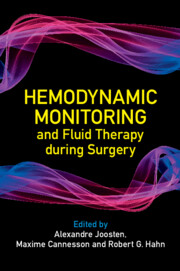Book contents
- Frontmatter
- Contents
- List of Contributors
- Foreword by Jean-Louis Vincent
- Preface
- Section 1 Hemodynamic Monitoring in the Perioperative Period
- Section 2 Basic Science & Concepts in Fluid Therapy
- Section 3 Practical Use
- Section 4 Future Directions
- 22 Optimizing Hemodynamic Therapy by Monitoring Microcirculation: One Step Forward in Matching Tissue Oxygen Delivery to Consumption
- 23 Predictive Analytics and Artificial Intelligence
- 24 Clinical Decision Support and Closed-Loop Systems for Goal-Directed Hemodynamic Therapy
- 25 Postoperative Surveillance: The Rise of Wireless Sensors, Pocket Ultrasound Devices and AI-Enabled Tools
- 26 Can Perfusion Index Be Useful for Fluid and Hemodynamic Management?
- Index
23 - Predictive Analytics and Artificial Intelligence
from Section 4 - Future Directions
Published online by Cambridge University Press: 11 April 2024
- Frontmatter
- Contents
- List of Contributors
- Foreword by Jean-Louis Vincent
- Preface
- Section 1 Hemodynamic Monitoring in the Perioperative Period
- Section 2 Basic Science & Concepts in Fluid Therapy
- Section 3 Practical Use
- Section 4 Future Directions
- 22 Optimizing Hemodynamic Therapy by Monitoring Microcirculation: One Step Forward in Matching Tissue Oxygen Delivery to Consumption
- 23 Predictive Analytics and Artificial Intelligence
- 24 Clinical Decision Support and Closed-Loop Systems for Goal-Directed Hemodynamic Therapy
- 25 Postoperative Surveillance: The Rise of Wireless Sensors, Pocket Ultrasound Devices and AI-Enabled Tools
- 26 Can Perfusion Index Be Useful for Fluid and Hemodynamic Management?
- Index
Summary
In perioperative medicine, optimal fluid management during and after the surgery is often debated. However, it is clear that poor fluid management and periods of hypotension are closely linked to worse outcomes. Both excessively liberal and restrictive fluid regimens lead to harm. Goal-directed pathways, where fluid or vasopressor administration targets a predefined hemodynamic parameter, are occasionally used. However, these require advanced hemodynamic monitoring, have limited evidence to support them and are often too complex, resulting in unsuccessful implementation.
Artificial intelligence (AI) focuses on machines capable of replicating human decision making. Within AI, predictive analytics use existing data to predict future events. These predictions can be integrated into open- or closed-loop systems, guiding fluid or vasopressor administration and reducing the clinician’s cognitive burden. This chapter provides an introduction to predictive analytics in perioperative fluid management, an overview of published literature, andsuggestions as to how the technology might develop in the future.
Keywords
- Type
- Chapter
- Information
- Hemodynamic Monitoring and Fluid Therapy during Surgery , pp. 267 - 275Publisher: Cambridge University PressPrint publication year: 2024

